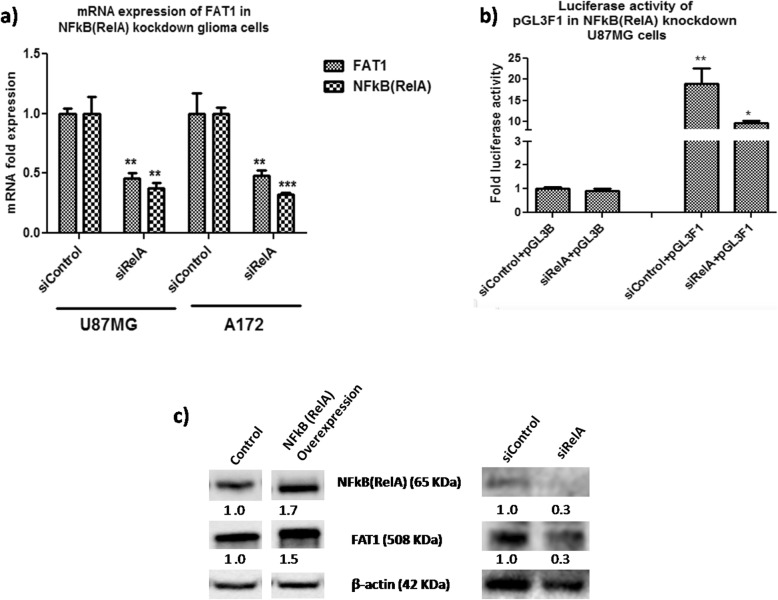Fig. 6.
Effect of NFкB inhibition on FAT1 promoter activity and FAT1 expression in glioma cells. a U87MG and A172 cells were transfected with NFкB (RelA) specific siRNA (siRelA- 100 μM) and siControl (100 μM) for 48 h. Using qPCR, U87MG and A172 showed 63 and 68% knockdown of NFкB (RelA), respectively. U87MG showed decreased FAT1 mRNA expression by 55%, while in A172 FAT1 mRNA expression decreased by 52% in comparison to siControl-treated cells. b U87MG cells were co-transfected with NFкB (RelA) specific & control siRNA (siControl/siRelA) and pGL3B/pGL3F1 promoter constructs (pGL3F1 + siControl, pGL3F1 + siRelA, pGL3B + siControl and pGL3B + siRelA) to analyze FAT1 promoter activity after 48 h post transfection. Glioma cells transfected with pGL3F1 + siControl showed significant increase in FAT1 promoter activity (18.98 fold ±3.63) as compared to control cells (siControl+pGL3B) cells. The increased luciferase activity of pGL3F1 was significantly abrogated by siRelA as compared to siControl (from 18.98 fold ±3.63 to 9.53 fold ±0.66 luciferase activity). Bar graphs represent fold luciferase activity of FAT1 promoter constructs (normalized to pGL3Basic and internal control pRLTK) and fold mRNA expression. Values are mean ± SE of at least three independent experiments performed in triplicates. Statistical analysis was performed using a paired two-tailed Student’s t-test. P-value < 0.05 was taken as significant (*p < 0.05, **p < 0.01, ***p < 0.001). c Western blot analysis showed increased FAT1 protein level upon overexpression of NFкB (RelA) and decreased FAT1 protein level upon NFкB (RelA) knockdown in U87MG cells. β-actin was used as a loading control

